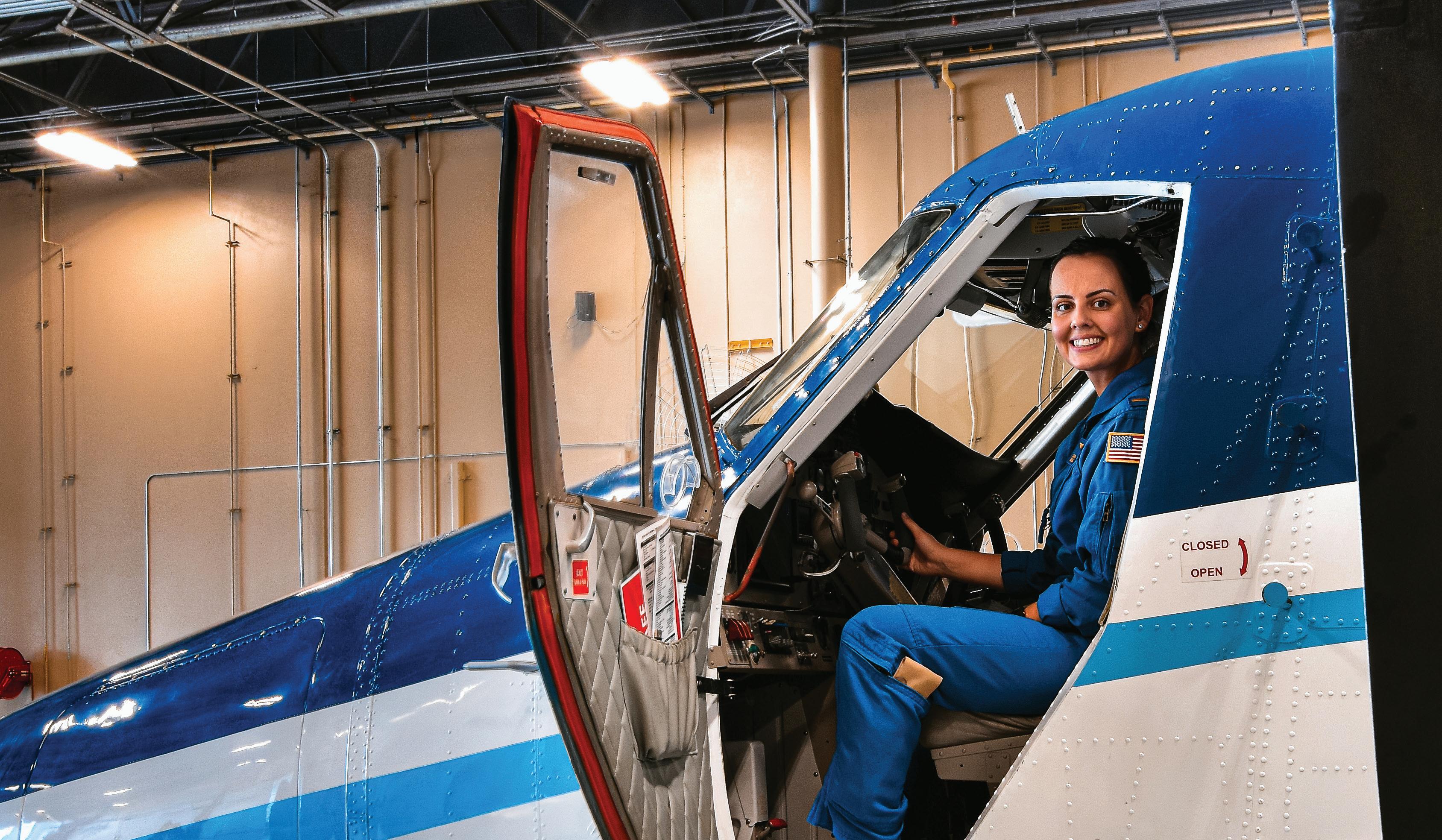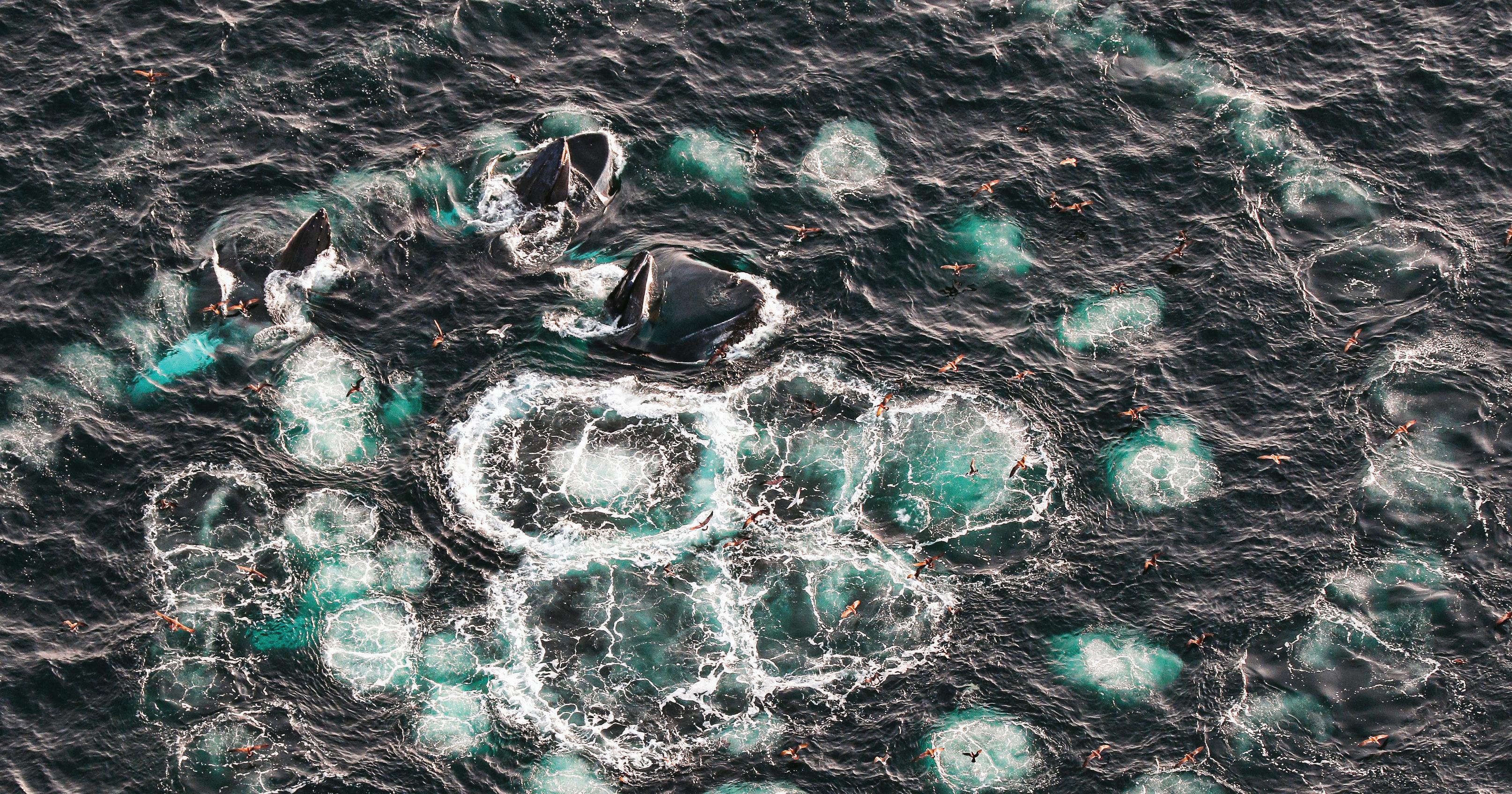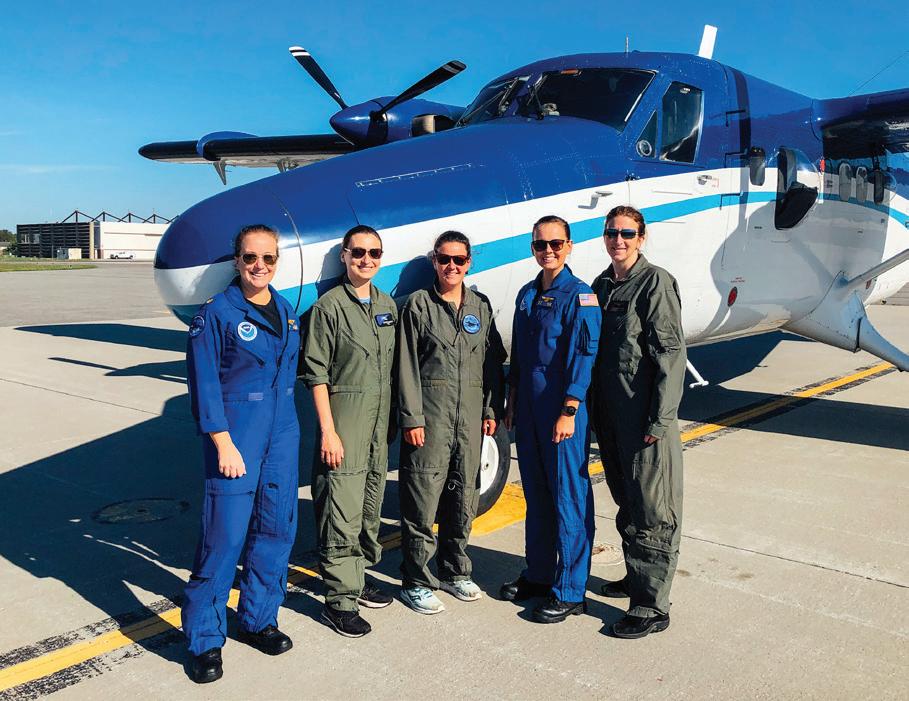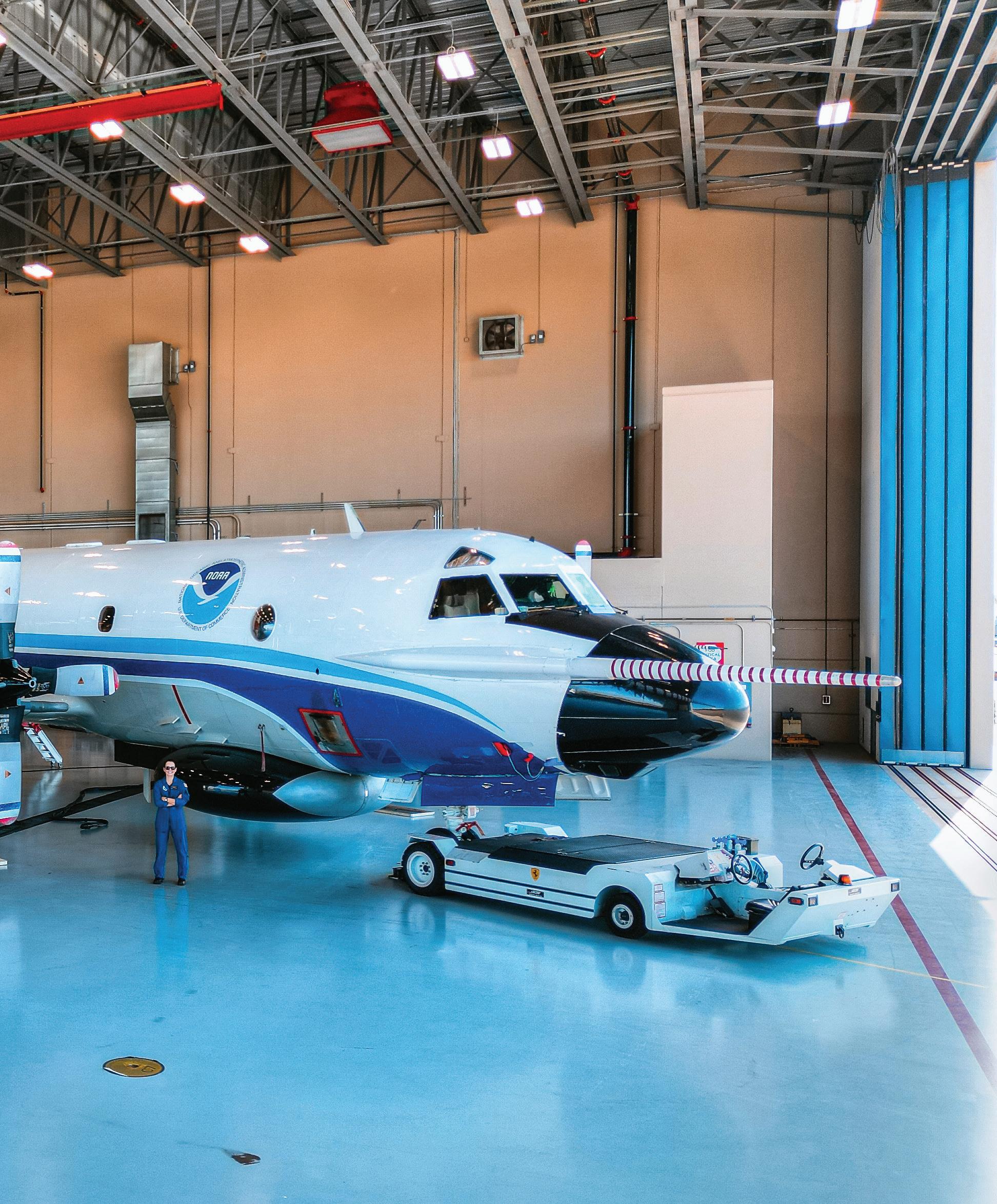
10 minute read
COVER STORY
Written by RJ Walters Photos by Adam Novak Designed by Jon Sierra
A brief glance at Sarah Cozart’s last year in the field makes perfect sense for an environmental studies graduate.
The twist in the narrative arrives when you realize Cozart is doing those things while living out her childhood dream of being a pilot, and is also serving her country — all part of the vigorous, uncommon and, as she puts it, “gratifying” experience of being a member of the NOAA Corps.
Tracking endangered North Atlantic Right Whales. Coastal mapping. Surveying leatherback sea turtles. Garnering data on oceanic conditions in the arctic.

MORE THAN HURRICANE HUNTERS
NOAA, the acronym for the National Oceanic and Atmospheric Administration, is known by most people as the organization that employs “hurricane hunters” who fly directly into the eye of the storm. Cozart has her sights set on that and is on track to fly a Herculean P3 Orion or King Air in the future, but her ascent to that milestone is just as fascinating, and the 28 yearold’s current mission schedule portrays the critical work being done by NOAA that often goes unnoticed. When Cozart jumps into a Twin Otter aircraft (as shown on the cover and pgs. 39-40) to embark on another adventure that has been meticulously planned alongside her colleagues, mechanics and scientists, she is weaving another thread of an organizational legacy that dates back to 1807 when President Thomas Jefferson founded the U.S. Coast and Geodetic Survey to provide nautical charts to the maritime community. The reach of the organization, which consists of civilians as well as sworn in Corps service members like Cozart, stretches from the bottom of the ocean floor to beyond the clouds. NOAA’s work is essential to weather forecasts, severe storm warnings, fisheries management, coastal restoration and so much more. With climate change, population growth and access to new cutting-edge technology that reads and analyzes data about Earth, the work of NOAA and its Corps have been deemed more important than ever. In 2020, President Donald Trump signed legislation that authorized NOAA Corps to be provided the resources and funding to expand from 321 officers to a maximum of 500, while also enhancing officer benefits to better align them with other services members. The NOAA Aircraft Operations Center moved from MacDill Air Force Base to a brand new facility in south Lakeland in 2017. The expansive 156,000 foot headquarters is home to more than 100 staff, including 30-40 pilots as well as civilian workers that include everything from mechanics and IT professionals to finance and communications employees.



311 Easton Dr, Lakeland, FL 33803 $599,900
• 3 bedroom, 3 bath • 2,372 heated sq ft • Located in Central Lakeland • Hidden bonus room
6041 Abbey Oaks Dr, Lakeland, FL 33811 $849,900
• 4 bedroom, 3 bath • 3,189 heated sq ft • Stunning Pool home • Gated Abbey Oaks Neighborhood
FROM OUR FRIENDS
Travis Barlow

“My wife and I just purchased our second home using Brian again. This time it was a whole new animal because we were buying and selling. But Brian treats us and I am sure anyone as the most important client. Him and his team are super efficient, always super kind, and make what could be a stressful and chaotic experience feel like floating down the river on a tube. I will always be grateful to Brian, I see him as a friend now and will recommend him to anyone I know. As a bonus we get to see his smiling face on a bench while driving down Florida Ave. Whether you’re selling or buying, you should definitely call Brian. Thanks again Brian.”
Vickie Hamm

Brian was great to work with!!! He helped us every step of the way to sell our house of 27 years. He rejoiced with us when it sold !


Cozart decided at age 9 she wanted to be a pilot because “it was the most exciting thing she could think of,” but it wasn’t until she was already living that out as a captain for commercial airline Cape Air that she saw a career path that could marry her technical prowess and her love for the natural world.
She was attending a Women in Aviation conference in Orlando when she got a glimpse into the possibility of a career with NOAA by talking to a couple of Corps pilots.
“I think what really drew me to it was just that humble servitude attitude of, ‘Yes, we’re going to be these bad a-- pilots, going into whatever mission NOAA has for us, but we’re doing it because we want to serve and we want to help science,’” Cozart says.
What followed would be considered bold for most, but just another marker on an adventurous course for Cozart and her husband Chaquille who she met at Liberty University, where she graduated from in 2016 with a degree in aeronautical science.
As part of the program at Liberty, Cozart earned her private, commercial and multiengine instrument ratings. She also spent a year doing grueling hands-on work at maintenance school.
She went on to enroll at Montana State University in Billings, Mont. where she concurrently landed a gig as a mechanic for Cape Air.
“I just remember at my interview, they were like, ‘How much do you know about sheet metal?’ So I’m like, ‘Well, I did like one class, like last year, you know? And they’re like, ‘Okay, you’ll learn real quick!’”
She worked alongside mechanics who had been working in the field north of 40 years and who could recite exact nut and bolt part numbers for specific planes.

A DREAM WORTH WORKING FOR



She then earned an incredible wealth of professional experience, as well as some gray hairs as she tells the story, when she piloted commercial flights for three years and learned what it’s like to be responsible for souls on board.
It was at that point she learned about NOAA, and soon after she was waking up in New London, Conn. every morning for 20 weeks, the necessary route to become an ensign in the NOAA Corps.
“With our partners at the Coast Guard…we learn how to drive ships, we do firefighting…have you seen the dunker training, like when a helicopter goes down and you have to get out while it’s upside down underwater?” she says. “ I kind of went into it blind, and it was a great awakening of like, okay, this is a service branch, this is real.”
Cozart said she wants more people to understand the real opportunity they have to make a difference. NOAA is currently accepting applications for its next session of basic officer training classes. Applications can be completed at omao. noaa.gov/learn/noaa-corps/ join/applying, and are due by November 11.
NOAA usually selects 16-17 candidates to enroll in boot camp, who then start their service on a ship, or as a pilot like Cozart if they are qualified and trained. NOAA Corps officers direct 15 ships around the world, and there is a wide variety of air, land and sea missions for assignment.


NEW DAY, NEW ADVENTURE
When The Lakelander visited with Cozart in August, it was T minus 18 hours before she and a colleague took off for a multiweek mission in Sacramento California to fly into a scorched region devastated by wildfires to collect air samples and data that could potentially help prevent future fires.
The preparation for missions is meticulous. A comprehensive self-evaluation is done, the logistics are checked and double checked and a pilot’s strategically devised plan is approved by a supervisor.
“We go through everything that could possibly be a risk, and we try to mitigate it,” Cozart says. “It’s a pretty extensive process, and we start that a month or more in advance.”
Cozart showed us around and inside the spotless twin otter plane that she was set to share with several scientists who could plug their specialized equipment into an array of ports inside the plane. The camaraderie between pilots and the mechanics was evident as they joked with each other and showed a reverence for their shared devotion to the work at hand.
“There’s definitely a bond, and the co-workers are the best part of the job,” says David McGee, a mechanic who works on the twin otters and the King Air planes. “The missions are really cool, and we know that having the planes in great working shape, ready to go, makes a big impact.”

Once that Twin Otter disappears into the Central Florida sky, what’s ahead of Cozart and her fellow NOAA pilots is planned, yet as unpredictable as the weather.
Earlier this year Cozart was on a mission in the Gulf of St. Lawrence, Canada where they were working to locate a whale that had been entangled in fishing gear, as well as teaming up with authorities to prevent future entanglements.
One day the team spotted the whale in the ocean, and the team started circling the giant specimen at a 45-degree angle to prepare for action.
“It’s just super emotional when you see a whale struggling in fishing gear... this is what we came up there to find,” Cozart says.
What happened next evoked a different kind of emotion. A strong storm developed in the area and the threat of strong winds and lightning was imminent. The team had to make a swift and necessary decision to abort the mission for the time being. The whale disappeared and NOAA Corps eventually handed off the mission to its Canadian counterparts, Fisheries and Oceans Canada.
Cozart said it stung to not be able to have to fly home without freeing the whale, but it’s comforting to know hope still remained.
“That’s the thing — weather and animals and coastal mapping and all of these things, like natural disasters — they don’t see borders,” she says with a laugh. “That’s why it’s so important to be working together with people all over the world, whether in Canada or in Africa where the Corps was recently on a mission.”



CONTINUAL ASCENT
Next up for Cozart is a promotion to Aircraft Commander, meaning she will be primarily responsible for building and executing the blueprints for missions, as well as working with and supporting up-and-coming co-pilots.
She is also looking forward to one day soon piloting aircraft like the P3 Orions, where she will have the opportunity to fly into potentially life-altering, devastating storms to provide real-time information that can enact safety protocols and save lives in real-time and in the future.
The future is equally promising for NOAA.
Jonathan Shannon, Public Affairs Specialist for NOAA, said they are scheduled to receive their third King Air plane in Lakeland by 2023, and have hopes of adding a Gulfstream G550 by 2024.
Cozart said she hopes to follow in the footsteps of fellow officers like Admiral Nancy Hann who was a Mariner as well as pilot.
“I’ll keep flying these really cool missions…and I’ll go to a land assignment in a couple of years,” Cozart estimates. “I’m not sure exactly where that will take me… but I’m excited to see.”


READY TO FLY?

NOAA is recruiting for its next class of NOAA Corp officers for water, land and sky. Apply through Nov. 11 at www.omao.noaa.gov/learn/noaa-corps/join





